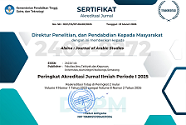Menakar Kembali Konsep Kala pada Fiʿil Māḍī Menurut Nuḥāt (Kajian Reflektif untuk Pembelajaran Bahasa Arab)
DOI:
https://doi.org/10.21580/alsina.3.1.10884Keywords:
Tense, Fiʿil, Māḍī, NuḥātAbstract
The most often discussed topics concerning nahw (Arabic grammar) are ism (noun), fi’il (verb), and hurf (letter). Fi'il (verb) can be classified into māḍī, muḍāriʿ, and amar. As well as past (māḍī), present (muḍāriʿ), and future (mustaqbal). The study of time in Arabic is critical. The purpose of this study is to examine fiil māḍī using a content analysis method. This study reported that Arabic grammarians (Nuḥāt) have diverse opinions on time in fiʿil māḍī, particularly to state implications in the current and future time, an argument that is bolstered by the fact that the Assyrian language also uses it. In Arabic, the term fiʿil ghayr tām (Muḍāriʿ) refers to both present and future events. The researchers suggested to use several reading methods to improve students' Arabic understanding, including Al-Qirā'ah al-Muwassaʿah (Extensive Reading), Al-Fahm al-Qirā'ī (Reading Comprehension) and Al-Qirā'ah al-Nāqidah (Critical Reading).Downloads
References
Abdelaziz, Zakaria, and Zakaria Mahmoud. “Past-Tense Verbs of Futurity in the Holy Quran: A New Text-World Theory Approach.” International Journal of Applied Linguistics and English Literature 7, no. 7 (December 1, 2018): 110. https://doi.org/10.7575/AIAC.IJALEL.V.7N.7P.110.
“Al-Aḍḍāḍḍ Fī Al-Lughah.” Majallat Al-Lisān Al-ʿArabī 8, no. 1 (n.d.).
Al-Anbārī, Kamāl al-Dīn Abū al-Barakāt Abd ʿal-Raḥmān ibn Muḥammad ibn Abī Saʿīd. Al-Inṣāf Fī Masā’il Al-Khilāf Bayn Al-Naḥwīyīn: Al-Basharīyīn Wa-Al-Kūfīyīn. Damaskus: Dār al-Fikr, n.d.
Al-Dobaian, Abdullah S. “A Syntactic Analysis of Arabic Tense and Aspect.” Advances in Language and Literary Studies 9, no. 6 (December 28, 2018): 82. https://doi.org/10.7575/AIAC.ALLS.V.9N.6P.82.
Al-Farrā’, Abū Zakarīyā Yaḥyā ibn Ziyād ibn ʿAbd Allāh ibn Manẓūr ibn Marwān al-Aslāmī al-Daylāmī al-Kūfī. Maʿānī Al-Qur’ān. Cairo: Dār al-Kutub al-Miṣrīyah, 1955.
Al-Raḍī, Muhammad al-Ḥasan al-Istirābādhī. Sharḥ Al-Raḍī Li-Kāfīyat Ibn Al-Ḥājib. Riyadh: Imam Mohammad Ibn Saud Islamic University, 1966.
Al-Sairāfī, Abū Saʿīd Al-Ḥasan ibn ʿAbd Allāh Ibn Al-Marzubān. Sharḥ Kitāb Sībawayh. Beirut: Dār al-Kutub al-ʿIlmīyah, 2008.
Al-Suyūṭī, Jalāl al-Dīn ʿAbd al-Raḥmān ibn Abī Bakr ibn Muḥammad ibn Sābiq al-Dīn. Hamʿ Al-Hawāmiʿ Fī Sharḥ Jamʿ Al-Jawāmiʿ. Beirut: Dār al-Kutub al-ʿIlmīyah, 1998.
Alhaigami, Salah Abdulsalam Qassim. “Tense and Aspect Denotation of Verb in Arabic Language A Linguistic Critical Study on Selected Examples of the Noble Quran.” ARID International Journal of Social Sciences and Humanities 3, no. 6 (July 15, 2021): 297–318. https://doi.org/10.36772/ARID.AIJSSH.2021.3613.
Anīs, Ibrāhīm. Min Asrār Al-Lughah. 3rd ed. Cairo: Maktabat Anglo al-Miṣrīyah, 1966.
Badrī, Kamāl Ibrāhīm. Al-Zamān Fī-Al-Nahw Al-ʿArabī. Riyadh: Dār Ummīyah li-al-Nashr, n.d.
Ibn Al-Sirāj, Abū Bakr Muḥammad ibn al-Sirrī ibn Sahl al-Naḥwī. Al-Uṣūl Fī Al-Naḥw. Beirut: Mu’assasat al-Risālah, n.d.
Ibn Jinnī, Abū al-Fatḥ ʿUthmān. Al-Khaṣā’iṣ. Riyadh: ʿĀlim al-Kutub, 2006.
Khawārizmī, Muḥammad bin Aḥmad. Mafātīh Al-ʿUlūm. Egypt: Idārat al-ṭibāʿah al-Munīrīyah, n.d.
Lyons, John. Introduction to Theoretical Linguistics. Cambridge: Cambridge University Press, 1968. https://doi.org/10.1017/CBO9781139165570.
Mudhsh, Badri Abdulhakim D.M. “A Comparative Study of Tense and Aspect Categories in Arabic and English.” Cogent Arts and Humanities 8, no. 1 (2021). https://doi.org/10.1080/23311983.2021.1899568.
Nasiruddin. “‘Kala’ dalam Bahasa Arab (Kajian Waktu Kebahasaan).” Alfazuna: Jurnal Pembelajaran Bahasa Arab Dan Kebahasaaraban 3, no. 2 (2019). https://doi.org/10.15642/alfazuna.v3i02.
Nur, Tajudin. “Pernyataan Kala Dan Aspek Dalam Bahasa Arab: Analisis Semantik Verba.” Arabi : Journal of Arabic Studies 3, no. 1 (June 30, 2018): 35–51. https://doi.org/10.24865/AJAS.V3I1.65.
Sībawayh, Abū Bishr ʿAmr ibn Uthmān ibn Qanbar Al-Biṣrī. Al-Kitāb (Kitāb Sībawayh). 3rd ed. Cairo: Maktabat al-Khanjī, 1988.
Downloads
Published
How to Cite
Issue
Section
License
Copyright
The copyright of the received article shall be assigned to the publisher of the journal. The intended copyright includes the right to publish the article in various forms (including reprints). The journal maintains the publishing rights to published articles. Authors are allowed to use their articles for any legal purposes deemed necessary without written permission from the journal, but with an acknowledgment to this journal of initial publication.
Licensing
In order for Alsina: Journal of Arabic Studies to publish and distribute research articles, the editors need publishing rights (transferred from author to publisher). This agreement relates to the transfer/publishing copyright license to Alsina: Journal of Arabic Studies but the authors still have significant rights to use and share their published articles.
Alsina: Journal of Arabic Studies supports the need for writers to share, disseminate and maximize the impact of their research and their rights on any database. As a journal article writer, you have the right to various uses of your articles, including that by the institution or company where you work. Copyright can be used without the need for special permission. Authors who publish articles in the Alsina: Journal of Arabic Studies have broad rights to use their work for teaching and scientific purposes without requesting permission, including:
- Use by the author for lectures, presentations, or conferences, with distribution of copies to participants;
- Distribution to colleagues for research use;
- Use in compilations of the author's subsequent work;
- inclusion in a thesis or dissertation;
- Reuse of sections or excerpts from articles in other works (with full acknowledgment of the final article);
- Preparation of derivative works (other than commercial purposes) (with full acknowledgment of the final article);
- Voluntary posting on open websites operated by authors’ or writers' agencies for scientific purposes
When submitting a manuscript, authors do so on the understanding that if accepted for publication, the copyright for publishing (publishing right) of the article shall be assigned/transferred to Alsina: Journal of Arabic Studies.
Authors whose articles are accepted for publication will receive confirmation via email and sent a Copyright Transfer Agreement.


 Accreditation
Accreditation 
 In Collaboration with
In Collaboration with 

 Visitors
Visitors  Article Template
Article Template





